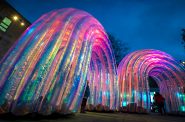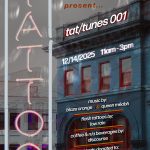Intentional art

Lyn Falk photo by Stephanie Bartz
Art. It’s a subjective subject. We all view art differently, and we can respond to the same piece of art differently at different times throughout our lives. So, what accounts for these differences?
We process art intuitively (emotionally), physiologically, and intellectually. Whether it’s sculpture, dance, music, poetry, journaling, storytelling, or painting, all art forms are sensory stimuli. It’s all energy, wavelengths of varying intensities, alerting our senses to take in information. When subjected to these varying art forms, our senses alert our brain to send out energy waves (messages) to the various systems that make up our body; nervous, hormonal, skeletal. And just as certain stimuli instantly, and positively or negatively, affect one’s immune system, so can art. Neurophysiologists have determined that “…art, prayer, and healing all come from the same source in the body, they all are associated with similar brain wave patterns…[they] all take us [deeper] into our inner world, the world of imagery and emotion, of visions and feelings.” Many feel healing comes from within, so when our own healing resources are freed up, we allow our immune system to operate optimally.
The above responses describe an automatic, instinctual response, but art also affects our rational thought and intellect (ego). For instance, when an abstract image is created, the viewer interprets it from a primitive, pre-verbal place. Words can’t quite express, so one feels. But when an artist creates a form that is familiar (i.e. a human form), our mind provides us with a perception, either based on a past experience, or it will create a new thought and experience. At this point, the viewer is responding on an intellectual (ego) level.
Art energy
What produces “art energy?” Basically two things: the medium from which the art has evolved, and the artist who created it. It is the combination of these energies that is perceived and felt by the viewer, but because we are fluid thinking and feeling humans who never remain the same, we will rarely respond to a piece of art the same way over a period of time. As the viewer changes, so does his perception of art.
Every medium emits a certain energy or rhythm. For instance, clay is made from earth’s soil and provides grounding energy. The form and texture into which it is molded can bring more active energy to the equation. Metal, made from earth’s elements, has a magnetic pull. It moves energy. Glass, made from sand and silicate, has a fluid energy. Art made from natural objects will always resonate better with the human mind and body than man-made (synthetic) objects because they are made from matter that more closely reflects our energy makeup. Paint, assuming it’s made from natural pigments, oils and binders, also has a fluid energy, but more subtle. It’s the color and texture of paint that creates influential energy. Our eyes receive a vibration from the color and texture and send signals to our brain, which in turn signals our body to react in a certain way. For instance, the cool colors (blue, green, purple), and smooth textures tend to relax our bodies, while the warmer colors (red, orange, yellow) and rough surfaces tend to activate us.
The artist
Artists create from a number of places. It can be from a place of intention in response to the viewer’s request, such as a commissioned piece, or it can be from a place of emotion; a non-manipulated free form of expression.

Artist Karen McCormick’s paintings often contain bold colors.
McCormick
Artist Karen McCormick taught art therapy at Mount Mary College in Milwaukee for 18 years before retiring last year. During her career, she worked with a Cherokee shaman who maintains that artists delve into energy sources that are not available to the rational mind. “I think because images are pre-verbal (as is sound and movement) they allow us to touch into energy, both in the dark realms and the light, that is otherwise inaccessible.”
McCormick explains that the amygdala is the instinctual core of the brain, the part where we experience anxiety or trauma, and it is assessable by imagery but not by words. She believes creating art can help the artist release blocked energy. “When an artist is in the moment and flowing with rhythmic energy, they lose all sense of time and can heal from an illness quite quickly. The sooner one can let down his defenses, the more rapid the healing.”
No training is needed. McCormick believes it’s the creative process that heals. “When I am painting from my mind, I quickly become bored and disappointed. But, when I follow my intuition, the paintings are full of surprises. I become aware of limitless possibilities; it puts me in the space of ‘all-potential.’ I use color combinations I wouldn’t normally choose and content that isn’t always rational, but it all works and seems so right. It is as if I am being guided by a higher, lighter intelligence. I think the viewer must, at some level, receive this sense of ‘all potential’ and the reassurance of a greater intelligence.” She believes that when an artist works purely from her heart, the work will often be well received by the viewer. “When an artist is truly connected to (their) source, the viewer sees it and feels it in the finished piece.”
Painting helps McCormick understand and appreciate her role as co-creator in her own life, an empowering experience. It was through art that McCormick discovered she was assaulted as a child. She could see it in her paintings. Color red would take her into that hurting place. Gradually, she was able to heal through her work.
McCormick has seen how bodies and minds become hungry for art; for color and texture. Colors hold energy and relate to the body’s seven charkas, or energy centers. Art can nurture us simply by giving us the colors we need in our lives. McCormick knows when her body needs a certain color. She will buy a big piece of fabric in that color and lay it on her bed for her body to absorb the vibrations at night. She has found that in winter we will paint rooms in our home in colors that are different from what we would choose in the summer, responding to our bodies’ needs.
Cassou
Internationally renowned artist, Michele Cassou, has designed a revolutionary way to remove blocks and unleash one’s creative potential by exploring the spiritual dimensions of the creative process. Called “Point Zero” method, this self-questioning “process painting” technique leads an artist into his “wild, untamed place where there are no judgments or rules. The unrestricted flow of images and colors will bring healing and insights.” No prior experience or special gifts are necessary to do this work. Cassou’s belief is that “what is authentic and beautiful in you will manifest when obstacles are removed and creativity is understood.”
Lighthart
Milwaukee native Deborah Lighthart has wanted to be a professional artist since she was a young child. Ten years ago, she bought paints for her kids while they were on a family vacation. She started painting and couldn’t stop. Angels were the first subjects she painted, which is not surprising considering she is a practicing psychic and healer. It was only natural that the spiritual and intuitive aspects of her daily work would come out in her painting.
Initially, she began simply painting for herself. Then someone showed up in her life, insisting on purchasing a three-dimensional self-portrait she had made out of homemade paper. The interesting part of this story is that Lighthart had decided she didn’t like the portrait so she had folded it up and tossed it into a miscellaneous pile of work. When a client saw it and insisted she needed it, Lighthart was reluctant to sell it, thinking, “How can someone love such a personal piece?” When her client refused to give up, Lighthart straightened it out, fixed it up, and framed the piece. She broke down and cried the day she sold it, realizing the unlovable part of herself was indeed, lovable. Lighthart feels all art heals some part of the artist, and/or the person for which the work is being created.
Francene Hart is another internationally recognized visionary artist. Similar to other intentional artists, her paintings act as a bridge between reality and the “metaphorical world of healing, continuity, and transformation.” After 25 years in the woodlands of northern Wisconsin, she now resides in Hawaii. She has spent years travelling the world studying indigenous cultures. These studies, along with exploration into metaphysical thought, yoga and sacred geometry, have deepened her belief that “we exist in a multi-dimensional reality and that we can access other dimensions in various ways.”
Sacred geometry has added another dimension to her art making. It’s a “piece of left-brained information that has brought great excitement and balance” into her life. She created the “Sacred Geometry Oracle Deck” as an instructional key to understanding the way the universe is designed. She refers to this work as “the language of light and science of compassion. The images and shapes are embedded in DNA, mandalas, pyramids, crystals and well, everything. Anyone who has ever gazed at a spider’s web, meditated on a mandala, visited a pyramid, walked a labyrinth, or peered through a microscope has felt the effects of sacred geometry.”
Final thoughts
Change the art in your life as often as you’d like. When you need to shift energy in your life, create or buy a new piece of art. When you venture out to purchase a piece of art, think about where you are in your life and what you need in your life. Do you need calming? Inspiration? Healing? Happiness? What will feel good? What will feed your soul? If a piece of art calls out to you, spend a minute with the feeling. You just might learn something about yourself, or heal something inside.
If you’re so inspired, pick up a paintbrush and see what happens. Remove mental obstacles and feel yourself fall into a place where energy flows freely and you’re trusting your intuition. When you’re stuck, you’re in your mind too much. McCormick says, “When stuck, keep moving your brush.”
Thank you, Karen. I couldn’t have said it better myself.
Art
-
Winning Artists Works on Display
 May 30th, 2024 by Annie Raab
May 30th, 2024 by Annie Raab
-
5 Huge Rainbow Arcs Coming To Downtown
 Apr 29th, 2024 by Jeramey Jannene
Apr 29th, 2024 by Jeramey Jannene
-
Exhibit Tells Story of Vietnam War Resistors in the Military
 Mar 29th, 2024 by Bill Christofferson
Mar 29th, 2024 by Bill Christofferson





















Thank you for this article. I don’t often read articles about art, preferring to let my responses come from the vast uneducated realm of me, but I took a chance and read this. I’m glad that I did because it has suggested multiple directions to follow in my thoughts and with my paints and brushes. I believe I’ll be going forth with less predetermined intention and more desire to take risks and see what happens when I just paint.
Thanks for some new creative breezes. They may well pull me along out of just floating in doldrums.